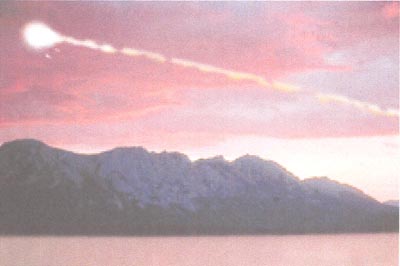| If
you see a fireball:
When a solid object enters
the Earth's
atmosphere, it interacts
with air molecules,
heats up to over 2000
degrees Fahrenheit,
and begins to glow.
The incandescent object
is called a meteor.
Most meteors are produced
by incoming
microscopic particles
of dust left
behind by the passage
of comets. These produce periodic meteor showers (see list
maintained
by
the American Meteor Society).
Occasionally, a larger
object enters the
Earth's atmosphere, producing
a very bright
meteor. If the
meteor is brighter than the
planet Venus, it is called
a fireball. A bright
fireball will produce
meteorites (which may or
may not be found).
When there are a
sufficient number of
eyewitness reports of
a fireball, meteoriticists
can often determine the
location where the
resulting meteorite(s)
landed and meteorite
samples can be recovered.
If you see a fireball
in the Pacific Northwest,
please fill out the fireball
report form (click
here for form) and mail it to
the Cascadia Meteorite
Laboratory
(address on the form)
or phone Dick Pugh
at (503) 287-6733.
|

Tagish Lake Fireball
of January 18, 2000
Artist's rendition of
the Tagish Lake Fireball
by Beet Korner, used
with permission of the
University of Ontario
website for the Tagish Lake Meteorite/Fireball Investigation:
Click
here for reference |

